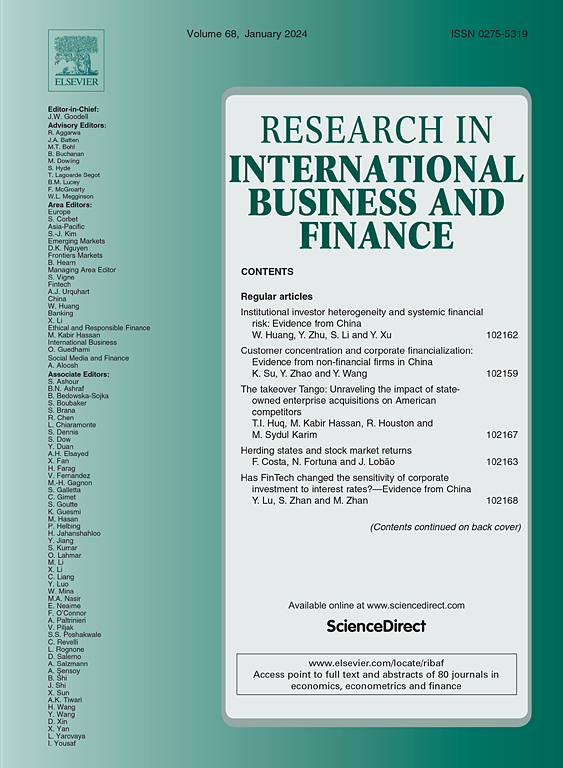The clout of happiness and uncertainty in the environmental transition: Insights from CO2 and clean energy dynamic spillovers
IF 6.9
2区 经济学
Q1 BUSINESS, FINANCE
Research in International Business and Finance
Pub Date : 2025-02-01
DOI:10.1016/j.ribaf.2024.102699
引用次数: 0
Abstract
This study explores the interconnection between clean energy, CO2 emissions, uncertainty in economic news, and happiness sentiment in the context of environmental transition. Our dataset includes daily returns from Twitter sentiment indices for happiness and uncertainty, as well as the clean energy and carbon emission indexes for the period that spans from June 2nd, 2011, to April 21st, 2023. We investigate the dynamic spillover effects across bear, normal, and bull markets using a quantile vector autoregression (QVAR) model. Furthermore, we investigate, via Augmented E-GARCH and GJR-GARCH models, the effects of investors’ emotion on the volatility of clean energy and CO2 emissions. Several important findings come from our analysis: First, during tranquil periods, there is a low spillover effect among the system. However, we find strong dynamic connections, especially at the extreme upper and lower quantiles, illustrating heightened sensitivity under volatile market conditions. Further, our findings indicate that clean energy and CO2 emissions serve as net spillover transmitters in both bear and normal markets. Finally, we observe that the clean energy volatility exhibits greater sensitivity to extreme shifts in happiness and uncertainty than CO2 emissions, highlighting the vulnerability of clean energy investments to investors sentiment fluctuations within the environmental transition. Our findings offer insightful advice for investors and regulators seeking to navigate the challenges of environmental shifts.

环境转型中幸福感和不确定性的影响:来自二氧化碳和清洁能源动态溢出效应的见解
本研究探讨环境转型背景下,清洁能源、二氧化碳排放、经济新闻不确定性与幸福感之间的关系。我们的数据集包括2011年6月2日至2023年4月21日期间Twitter上幸福感和不确定性情绪指数的日收益,以及清洁能源和碳排放指数。我们使用分位数向量自回归(QVAR)模型研究熊市、正常市场和牛市的动态溢出效应。在此基础上,通过增强的E-GARCH和GJR-GARCH模型,研究了投资者情绪对清洁能源波动率和二氧化碳排放的影响。我们的分析得出了几个重要的发现:第一,在平静时期,系统之间的溢出效应较低。然而,我们发现强烈的动态联系,特别是在极端的上分位数和下分位数,说明在波动的市场条件下灵敏度提高。此外,我们的研究结果表明,在熊市和正常市场中,清洁能源和二氧化碳排放都是净溢出传导器。最后,我们观察到清洁能源波动比二氧化碳排放对幸福感和不确定性的极端变化表现出更大的敏感性,这凸显了环境转型中清洁能源投资对投资者情绪波动的脆弱性。我们的研究结果为寻求应对环境变化挑战的投资者和监管机构提供了深刻的建议。
本文章由计算机程序翻译,如有差异,请以英文原文为准。
求助全文
约1分钟内获得全文
求助全文
来源期刊

Research in International Business and Finance
BUSINESS, FINANCE-
CiteScore
11.20
自引率
9.20%
发文量
240
期刊介绍:
Research in International Business and Finance (RIBAF) seeks to consolidate its position as a premier scholarly vehicle of academic finance. The Journal publishes high quality, insightful, well-written papers that explore current and new issues in international finance. Papers that foster dialogue, innovation, and intellectual risk-taking in financial studies; as well as shed light on the interaction between finance and broader societal concerns are particularly appreciated. The Journal welcomes submissions that seek to expand the boundaries of academic finance and otherwise challenge the discipline. Papers studying finance using a variety of methodologies; as well as interdisciplinary studies will be considered for publication. Papers that examine topical issues using extensive international data sets are welcome. Single-country studies can also be considered for publication provided that they develop novel methodological and theoretical approaches or fall within the Journal''s priority themes. It is especially important that single-country studies communicate to the reader why the particular chosen country is especially relevant to the issue being investigated. [...] The scope of topics that are most interesting to RIBAF readers include the following: -Financial markets and institutions -Financial practices and sustainability -The impact of national culture on finance -The impact of formal and informal institutions on finance -Privatizations, public financing, and nonprofit issues in finance -Interdisciplinary financial studies -Finance and international development -International financial crises and regulation -Financialization studies -International financial integration and architecture -Behavioral aspects in finance -Consumer finance -Methodologies and conceptualization issues related to finance
 求助内容:
求助内容: 应助结果提醒方式:
应助结果提醒方式:


